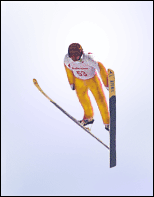Winter Olympics: Ski Jumping


Once a popular attraction at ski carnivals
by Beth Rowen
 Eddie "the Eagle" Edwards Related LinksMemorable MomentsDid You Know?The youngest male athlete to win an Olympic gold medal was 16-year-old Toni Nieminen of Finland, who won the large hill ski jumping event at the 1992 Winter Games in Albertville, France. |
Ski jumping was born in Norway, the country that has given us practically all of our Nordic skiing events. A popular attraction at ski carnivals in the mid-1800s, the first official ski jumping competition was held in Norway in 1872. Norwegian immigrants brought ski jumping to America just before the turn of the century.
The large-hill ski jumping competition has appeared at every Olympic Winter Games since 1924. Although its height has changed through the years, the hill has been fixed at 120 meters (394 ft) since the 1992 Winter Games.
The normal-hill event was introduced in 1964. Its height was set at 70 meters (230 ft) and remained so until 1992, when it was moved up to its current height of 90 meters (295 ft).
Jumpers compete in three events: individual normal hill, individual large hill, and team (which is contested on the large hill).
Each athlete attempts two jumps. Landings are videotaped for exact measuring purposes, and points are awarded based on the length of the jump. Longer jumps are awarded more points than shorter ones.
A panel of five judges rates each athlete's style on a scale from 0–20. The lowest and highest scores are dropped, making 60 a perfect score.
The skier, or team of skiers, with the highest combined total of distance points and style points is awarded the gold medal.
After years of barring women ski jumpers from the Winter Games, the International Olympic Committee announced in April 2011 that women would finally be allowed to compete, beginning in 2014 in Sochi. Women will vie for medals in the individual normal hill event. They are still denied the chance to participate in the large-hill and team events. With the inclusion of women's ski jumping, Nordic combined (ski jumping and cross-country skiing) remains the only event that lacks female competitors. In reversing itself, the IOC said that there were enough elite athletes in the sport to merit inclusion in the Games. "There is much more quality than there was two years ago," said Christophe Dubi, sports director of the IOC.
It was a long-fought victory. Fourteen women ski jumpers seeking to compete at the 2010 Games sued the Vancouver Olympic Organizing Committee (VANOC), claiming that their rights had been violated under the Canadian Charter of Rights and Freedoms. While the British Columbia Supreme Court agreed in a July 10, 2009, ruling that the women were being discriminated against, Justice Lauri Ann Fenlon stated that the court's hands were tied—the decision about inclusion was up to the IOC and neither the IOC nor VANOC are subject to the laws of the land. The jumpers appealed the court's decision. After two days of legal arguments, on Nov. 13, 2009, Judge Anne Rowles of the British Columbia Court of Appeal had these four words, "The appeal is dismissed."
Lindsey Van, the 2009 world champion, hopes to win the first gold medal in the event. Also watch out for Sarah Hendrickson, who won nine out of 12 world cup events in 2012, and Jessica Jerome, the first women to officially make the team. For the men, first-time Olympian Nicholas Fairall hopes to leave his mark on the sport. Veterans Anders Johnson and Peter Frenette are also strong contenders.







